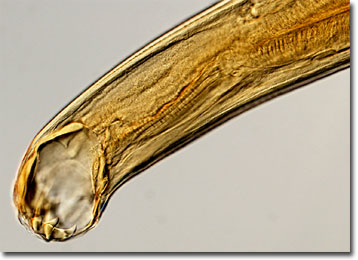Differential Interference Contrast Image Gallery
Ancylostoma Hookworm
Ancylostoma is a genus of hookworm whose species attach to the intestines of hosts in order to directly take blood meals from the small arteries they contain. The common name of the parasites stems from the characteristic hook-like appendages of their mouths, which are equipped with cutting plates for piercing the intestinal wall.

Hookworm infestation is known as ancylostomiasis and serious cases can result in as much as 200 milliliters of blood loss per day. The condition tends to be most prevalent in tropical regions and may affect animals, such as dogs and cats, as well as humans. Symptoms of ancylostomiasis vary by host, but often include diarrhea, weight loss, and severe anemia. In fact, during the late 1800s an epidemic referred to as miners' anemia occurred among Italian laborers building the Saint Gotthard railway tunnel in the Swiss Alps. The hookworm species Ancylostoma duodenale was responsible for the outbreak.
The lifecycle of hookworms is species dependent, but females tend to be extremely fertile, producing as many as 30,000 eggs in a single day. The ova are passed out of the host with other excreta and usually develop into larvae in warm, moist soil. Infective larvae are barely visible to the naked eye and most often enter a host through skin penetration, although oral ingestion is also possible. Once inside a host, the larvae migrate through the body eventually settling in the small intestine, where they begin feeding so that they may grow and mature to produce a new generation of hookworms.
